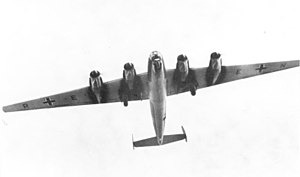Amerika Bomber
| Amerika Bomber project | |
|---|---|
 |
|
| The Messerschmitt Me 264 V1 (first prototype Me 264) | |
| Project for | Long-range strategic bomber |
| Issued by | Reich Air Ministry |
| Service | Luftwaffe |
| Date initiated | April 1942 |
| Proposals | Focke-Wulf, Heinkel, Junkers, Horten brothers and Messerschmitt (conventional bombers) |
| Prototypes |
Focke-Wulf Fw 300 Focke-Wulf Ta 400 Heinkel He 277 (after February 1943) Horten H.XVIII Junkers Ju 390 Messerschmitt Me 264. |
| Date concluded | July 1944, with the Jägernotprogramm. |
| Outcome | Five prototypes (two Ju 390, three Me 264) built, no operational aircraft |
| Predecessor programs |
Ural bomber Heinkel He 177 |
The Amerika-Bomber project was an initiative of the German Reichsluftfahrtministerium to obtain a long-range strategic bomber for the Luftwaffe that would be capable of striking the United States from Germany, a distance of about 5,800 km (3,600 mi). The concept was raised as early as 1938, but advanced, cogent plans for such a long-range strategic bomber design did not begin to appear in Reichsmarschall Hermann Göring's offices until early 1942. Various proposals were put forward, including using it to deliver an atomic bomb (which Germany ultimately never developed), but they were all eventually abandoned as too expensive, and potentially consuming far too much of Germany's rapidly diminishing aviation production capacity after 1942.
According to Albert Speer's book, Spandau: The Secret Diaries, Adolf Hitler was fascinated with the idea of New York City in flames. In 1937, Willy Messerschmitt hoped to win a lucrative contract by showing Hitler a prototype of the Messerschmitt Me 264 that was being designed to reach North America from Europe. On 8 July 1938, barely two years after the death of Germany's main strategic bombing advocate, Generalleutnant Walter Wever, and eight months after the Reich Air Ministry awarded the contract for the design of the Heinkel He 177, Germany's only operational heavy bomber during the war years, the Luftwaffe's commander-in-chief Hermann Göring gave a speech saying, "I completely lack the bombers capable of round-trip flights to New York with a 4.5-tonne bomb load. I would be extremely happy to possess such a bomber, which would at last stuff the mouth of arrogance across the sea." Canadian historian Holger H. Herwig claims the plan started as a result of discussions by Hitler in November 1940 and May 1941 when he stated his need to "deploy long-range bombers against American cities from the Azores." Due to their location, he thought the Portuguese Azores islands were Germany's "only possibility of carrying out aerial attacks from a land base against the United States." At the time, Portuguese Prime Minister Salazar had allowed German U-boats and navy ships to refuel there, but from 1943 onwards, he leased bases in the Azores to the British, allowing the Allies to provide aerial coverage in the middle of the Atlantic.
...
Wikipedia
